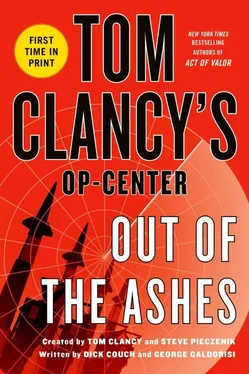This shoot house was a single-story facility with walls and movable partitions of heavy-rubber, bullet-absorbent material. Below Volner and Moore on the catwalk, their special operations troop ran standard room-clearing drills, moving from room to room like laboratory mice in a maze.
“Clear left!”
“Moving!”
“Clear right!
“Moving!”
“I’m down!”
“Coming up!”
The work in the house was proficiency drill for these veteran shooters. The game was initiative-based tactics or IBTs — moving and shooting, or not shooting, depending on the threat and the target. The teams progressed like members of a ballet company as they went from one room to the next, adjusting and readjusting their formations as needed. Down on the floor of the house, paper targets depicting swarthy men holding guns, or coffee cups, were shot or not shot depending on the threat posed. The troop worked in fire teams of four to six shooters. It was primarily a drill for the team leaders, but depending on the flow of the action, anyone on the team could be the lead shooter through any given door. It was full-on, close-quarter, live fire and movement.
“They’ve done this dozens of times,” Moore observed, “but they never seem to get tired of it.” Thanks to their Peltor Tactical Pro MT15H7B sound-canceling headphones the two senior leaders could speak in normal conversation in spite of the shouting and shooting below.
“That’s a good thing, because there’s a strong chance we’ll be doing a lot more training and a lot less operating. We’re just not the flavor of the month — and may not be for some time.”
Volner was referring to the shift in the focus of special operations to indirect action — the training of foreign soldiers and the embedding of American special operators with partner-nation forces. Volner’s troop, like all of the JSOC strike elements, was a direct-action team. If a good direct-action mission did come along, it could easily go to another troop, although Volner knew, as did his Master Guns, theirs was the top-rated troop among the JSOC special mission elements. That might count for something, Volner reasoned, but probably not.
“Of course,” Volner continued, “I’m kinda stuck here. You, on the other hand, could always get out and write a book. I can see it on the shelves, Master Guns Moore Tells It like It Was. ” Master Gunnery Sergeant Moore was also a tactical intelligence specialist and had been on the raid into Pakistan that led to the killing of Osama bin Laden. He led the site exploitation effort on that famous SEAL raid.
Moore rolled his quid from one side of his mouth to the other and considered this. “Sir, if I write a book, you have my standing permission to kick my ass up between my shoulder blades and then shoot me. I’m not some blabby-mouthed Navy SEAL.”
“I’ll take that under advisement, Master Guns.”
“You do that, sir. Meanwhile, let’s go down and see if one or two of those fire team leaders will let us in the stack. We got nothin’ else to do.”
Volner grinned. “Maybe, if we ask them politely.”
In a special operations assault, the key kinetic leaders were the fire team leads. The troop commander and the troop senior sergeant seldom had their guns in the fight. The troop sergeant managed the fight and coordinated the movement of his fire teams and the blocking elements. His troop commander was on two, and sometimes three, radios. He monitored the fight, coordinated the air assets, and kept higher headquarters informed. Both carried the responsibility for the fight, but they were seldom directly engaged. They ran the radios and stayed with the big picture. They could make adjustments and give direction, as a fight seldom goes as planned. Volner and Moore made their way down from the catwalk, each to a different fire team.
“Sergeant First Class Jamison,” Volner said to his alpha team leader. “Mind if I jump into the stack for a run or two?”
Jamison, a lanky former Special Forces A-Team sergeant, pursed his lips as he thought about his major’s request for a moment. “OK, Charlie, take a break.” Turning to Volner, he continued. “Major, you’ll be number four on the first door for this pass. And sir, I’d consider it a personal favor if you didn’t shoot one of my men.”
“Roger that, Sergeant,” Volner replied as he took his place in the file.
The White House Oval Office, Washington, D.C.
(January 10, 1330 Eastern Standard Time)
The president was not surprised, but his confidence was validated, when Chase Williams contacted him six weeks to the day after their initial meeting. He had cleared his calendar and waited for their early afternoon meeting. It was a blustery January day, yet the president, as was his custom, was in a crisp white shirt, tie loosened, and his sleeves rolled to his forearms.
“Admiral, welcome.”
“Thank you, Mr. President. I trust you and your family had a wonderful Christmas holiday.”
“We did manage to break away and spend some time at Camp David. I know your wife passed away some years ago, but were you able to spend some time with your children?”
“Yes, thank you for asking. Our daughter invited us to her home in the Hollywood Hills. Our son managed to wrangle a week off from Goldman Sachs and got out of Boston just hours ahead of the blizzard that hit the Northeast days before Christmas.”
“Good, that’s great to hear. So here we both are, Admiral, reasonably relaxed and refreshed.”
“Yes, Mr. President. And sir, if I may, can I ask that you call me Chase? Some people like to wear their former military rank to the grave. I’m not one of them. If you’re OK with it, Chase would be better.”
“Fair enough. Chase, then. So how should we proceed?”
“Mr. President, I’ve studied the issues we discussed and consulted with a small circle of friends and associates I trust implicitly and have come to some tentative conclusions. I think what I’m about to present to you will both frame our concept of operations for Op-Center and provide you with the confidence it can serve you and our nation’s interests.”
“I’m eager to hear what you have to say.”
“Thank you. First of all, Mr. Harward was right in what he said when we met here six weeks ago. Op-Center shouldn’t be the first thing that comes to mind when there is a crisis.”
“Good. I’m glad we agree on that.”
“I think, Mr. President, it’s important to give credit where credit is due. In the decade following 9/11, our traditional intelligence and security services became superb at finding and killing terrorists. Our conventional intelligence collectors and military capability were up to the task of containing the threats from Iran, North Korea, China, and Russia as they made attempts to export militarism or expand their spheres of influence, but things have changed.”
“I know they have, but how do we deal with these new threats?”
“As a start, Mr. President, we identify them for what they are. The available evidence we have thus far strongly suggests these stadium attacks weren’t the work of some agitated jihadists. This was a professional hit. The terrorists have taken a page from our use of contractors to support the U.S. military and have begun to contract out terrorism. Our current intelligence agencies and our military are superb at what they do. However, a decade of war in Iraq and Afghanistan, the focus on counterinsurgency, and the major budget cuts to our military capabilities have left us a step behind today’s emerging threats. This is especially true when it essentially becomes terror for hire.”
“So how do we get ahead of the power curve?”
Читать дальше












